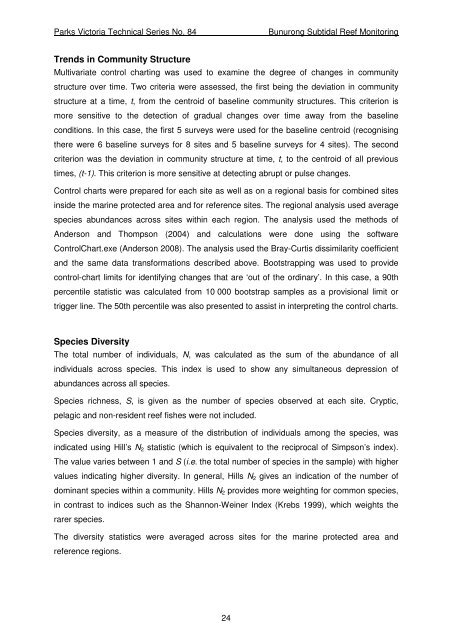the reef biota at bunurong marine national park - Parks Victoria
the reef biota at bunurong marine national park - Parks Victoria
the reef biota at bunurong marine national park - Parks Victoria
You also want an ePaper? Increase the reach of your titles
YUMPU automatically turns print PDFs into web optimized ePapers that Google loves.
<strong>Parks</strong> <strong>Victoria</strong> Technical Series No. 84<br />
Bunurong Subtidal Reef Monitoring<br />
Trends in Community Structure<br />
Multivari<strong>at</strong>e control charting was used to examine <strong>the</strong> degree of changes in community<br />
structure over time. Two criteria were assessed, <strong>the</strong> first being <strong>the</strong> devi<strong>at</strong>ion in community<br />
structure <strong>at</strong> a time, t, from <strong>the</strong> centroid of baseline community structures. This criterion is<br />
more sensitive to <strong>the</strong> detection of gradual changes over time away from <strong>the</strong> baseline<br />
conditions. In this case, <strong>the</strong> first 5 surveys were used for <strong>the</strong> baseline centroid (recognising<br />
<strong>the</strong>re were 6 baseline surveys for 8 sites and 5 baseline surveys for 4 sites). The second<br />
criterion was <strong>the</strong> devi<strong>at</strong>ion in community structure <strong>at</strong> time, t, to <strong>the</strong> centroid of all previous<br />
times, (t-1). This criterion is more sensitive <strong>at</strong> detecting abrupt or pulse changes.<br />
Control charts were prepared for each site as well as on a regional basis for combined sites<br />
inside <strong>the</strong> <strong>marine</strong> protected area and for reference sites. The regional analysis used average<br />
species abundances across sites within each region. The analysis used <strong>the</strong> methods of<br />
Anderson and Thompson (2004) and calcul<strong>at</strong>ions were done using <strong>the</strong> software<br />
ControlChart.exe (Anderson 2008). The analysis used <strong>the</strong> Bray-Curtis dissimilarity coefficient<br />
and <strong>the</strong> same d<strong>at</strong>a transform<strong>at</strong>ions described above. Bootstrapping was used to provide<br />
control-chart limits for identifying changes th<strong>at</strong> are ‘out of <strong>the</strong> ordinary’. In this case, a 90th<br />
percentile st<strong>at</strong>istic was calcul<strong>at</strong>ed from 10 000 bootstrap samples as a provisional limit or<br />
trigger line. The 50th percentile was also presented to assist in interpreting <strong>the</strong> control charts.<br />
Species Diversity<br />
The total number of individuals, N, was calcul<strong>at</strong>ed as <strong>the</strong> sum of <strong>the</strong> abundance of all<br />
individuals across species. This index is used to show any simultaneous depression of<br />
abundances across all species.<br />
Species richness, S, is given as <strong>the</strong> number of species observed <strong>at</strong> each site. Cryptic,<br />
pelagic and non-resident <strong>reef</strong> fishes were not included.<br />
Species diversity, as a measure of <strong>the</strong> distribution of individuals among <strong>the</strong> species, was<br />
indic<strong>at</strong>ed using Hill’s N 2 st<strong>at</strong>istic (which is equivalent to <strong>the</strong> reciprocal of Simpson’s index).<br />
The value varies between 1 and S (i.e. <strong>the</strong> total number of species in <strong>the</strong> sample) with higher<br />
values indic<strong>at</strong>ing higher diversity. In general, Hills N 2 gives an indic<strong>at</strong>ion of <strong>the</strong> number of<br />
dominant species within a community. Hills N 2 provides more weighting for common species,<br />
in contrast to indices such as <strong>the</strong> Shannon-Weiner Index (Krebs 1999), which weights <strong>the</strong><br />
rarer species.<br />
The diversity st<strong>at</strong>istics were averaged across sites for <strong>the</strong> <strong>marine</strong> protected area and<br />
reference regions.<br />
24

















